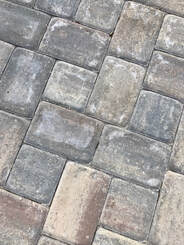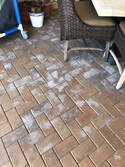Concrete Efflorescence
Efflorescence is a whitish haze that appears on the surface of your concrete pavers. This will typically occur in the first few weeks or months of installation, but can occur as late as a year or so later. It can also appear after heavy rainstorms. Efflorescence may also be referred to as calcium hydroxide or free lime.
Why are my concrete pavers turning white?

All concrete pavers contain cement. As the cement hydrates, it produces lime or water soluble salts, such as calcium hydroxide. The calcium hydroxide is soluble in water and therefore migrates to the surface of the concrete pavers through capillary action. When the calcium hydroxide reaches the surface of the pavers, a chemical reaction occurs with carbon dioxide in the air. As it reacts with carbon dioxide, calcium hydroxide forms a water insoluble calcium carbonate. This is what causes the whitish haze on the surface of the concrete pavers. As moisture evaporates off the pavers' surface, the whitish haze becomes more pronounced. Sometimes the calcium carbonate can crystalize and become solid.
In simple terms, calcium carbonate is a by-product resulting from an interaction between cement used to manufacture pavers and the natural environment (e.g. ground, weather, and atmosphere). The result is a deposit or salt that appears on the surface of the pavers. There is no single, definitive appearance. Sometimes it's powdery, scummy, or hazy. Other times it can be sharp, crisp, and obvious. Sometimes it covers large areas of pavers while other times it only covers individual units. Concrete efflorescence seems to affect dark hued pavers more than those of lighter tones. Truthfully it's just more noticeable against a dark background.
Another reason why your concrete pavers are turning white may be due to being improperly sealed. But that is a different problem which requires stripping and paver restoration.
In simple terms, calcium carbonate is a by-product resulting from an interaction between cement used to manufacture pavers and the natural environment (e.g. ground, weather, and atmosphere). The result is a deposit or salt that appears on the surface of the pavers. There is no single, definitive appearance. Sometimes it's powdery, scummy, or hazy. Other times it can be sharp, crisp, and obvious. Sometimes it covers large areas of pavers while other times it only covers individual units. Concrete efflorescence seems to affect dark hued pavers more than those of lighter tones. Truthfully it's just more noticeable against a dark background.
Another reason why your concrete pavers are turning white may be due to being improperly sealed. But that is a different problem which requires stripping and paver restoration.
How to stop efflorescence
Efflorescence is a completely natural occurrence. It usually occurs at the bottom of driveways with poor drainage. But it can also happen in random areas of concrete pavers. Most concrete paver manufacturers have attempted to control the problem of efflorescence by using an admixture in their products. However, no manufacturer has completely eliminated the problem. Efflorescence will continue to appear until the calcium hydroxide has had time to exhaust itself.
How to clean efflorescence

Most paver sealing contractors resort to commercial efflorescence cleaners. Your driveway, patio, sidewalks, etc. will have to be acid washed. Most cleaners will work effectively to reduce the haze when used properly and will eliminate or lighten the problem. But again, efflorescence will probably keep coming back until the calcium hydroxide has been exhausted. So future cleanings may be necessary.
If you are having a problem with concrete efflorescence and your property is located in the Naples / Fort Myers, Punta Gorda, FL metro area, we can help.
If you are having a problem with concrete efflorescence and your property is located in the Naples / Fort Myers, Punta Gorda, FL metro area, we can help.


